The ubiquitous dayflower
- jjvanm
- Sep 20, 2025
- 3 min read

Published September 20, 2025, in the McAllen Monitor
Story and photos by Anita Westervelt
My theory about dayflower is that it was here long before any of us, and we may be hard-pressed to find a yard without a nod or two of the ubiquitous plant.
Dayflower is also called whitemouth dayflower, slender dayflower and widow’s tears. Its scientific name is Commelina erecta. It is native. As a matter of fact, it is native to much of the world, according to Wikipedia.org, including the Americas, Africa and western Asia and beyond.
Not only is dayflower ubiquitous, it also is unique. It is one of the few flowers that does not produce nectar, only pollen. Each flower lasts only a day; flowers are small but distinctive. There are three petals, two are stunning, deep azure blue and prominent, the third petal is much smaller, white to translucent and rarely noticeable. The blue petals attract the attention of insects, such as flies and bees that gather pollen from the yellow anthers and pollinate the species somewhat by chance.

I say by chance because three of the beautifully contrasting yellow stamen-looking parts are actually a marketing strategy of the plant; they are stamenodes and do not produce pollen but help to draw insects to the flower. The larger elegant yellow attraction is the pollen-offering stamen. In addition, less conspicuous pollen resides at the tips of the swirly white strands that bookend the stigma, which constitutes the reproductive unit.

Dayflower reproduction isn’t just left to the happenstance of pollinators. The stems vigorously produce roots at the leaf nodes where they come in contact with soil. Detached plant parts that touch the ground also can grow into new plants. The plant also colonizes by tubers underground. The roots are a thick, fibrous mass, multi-fingered from a center, like an octopus. They anchor just below the surface of the soil and cannot be removed by pulling the plant’s stem, the roots must be dug up.
The plant’s reproduction ability via seeds is interesting, too; the plant produces two types of seeds, some are released dehiscent – shot from the plant, aiming for maximum range. Other seeds are coated and can remain dormant for extended periods. Seeds on the ground can be eaten by small granivores, like mice, rats and voles, that inadvertently help propagate the species.

The plant thrives in sunny or partially shaded locations with low nutrient requirements and drought conditions. Petal color may range from vibrant to lighter shades of blue and, less frequently, white. The stems are erect mainly when supported by surrounding plants. Crowded amongst other vegetation in high shade, dayflower struggles to the top on spindly, weak stems, reaching to the light.

Dayflower seems to be everywhere, pervasively peaking above and through other plants and often looking straggly and hard to control. In its favor though, it may be the only thing blooming in the coldest winter months and offering pollen. The seeds are important to a whole gallery of birds, like bobwhite quail, doves, redwing blackbirds, northern cardinals and sparrows. And that’s a good thing.
- 30 -





